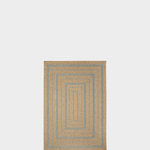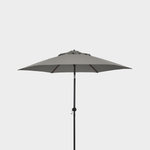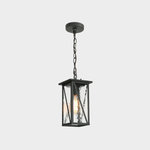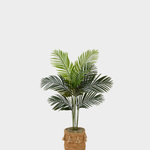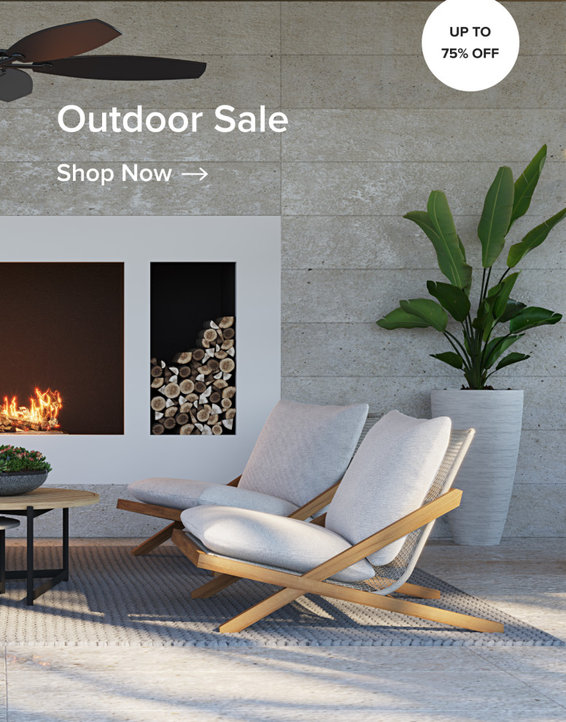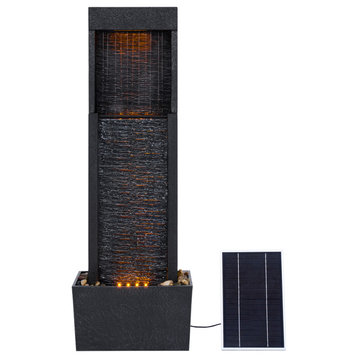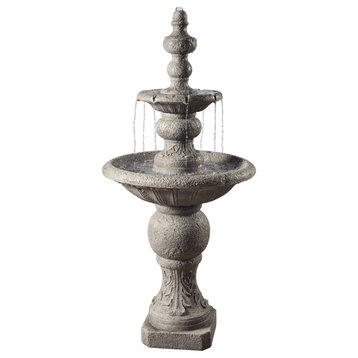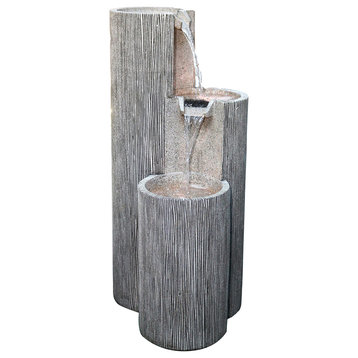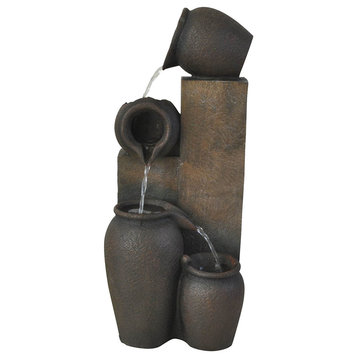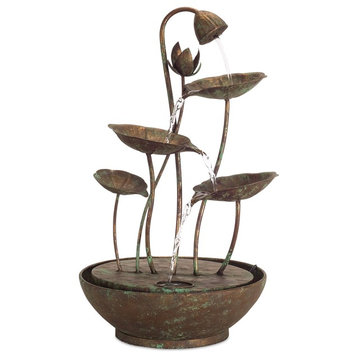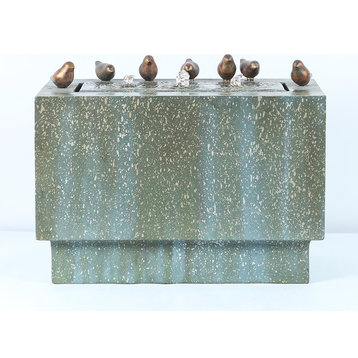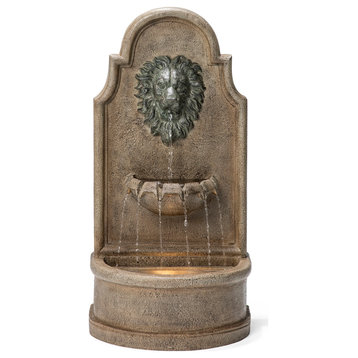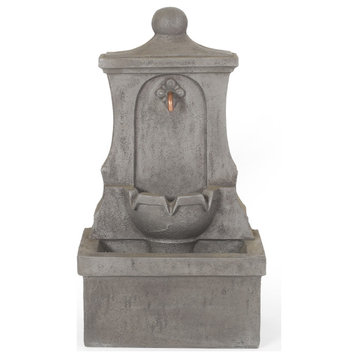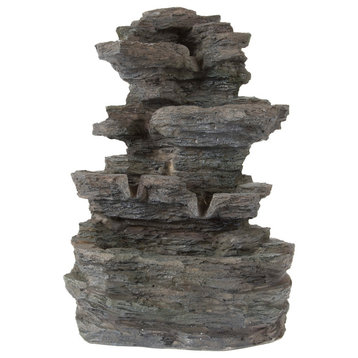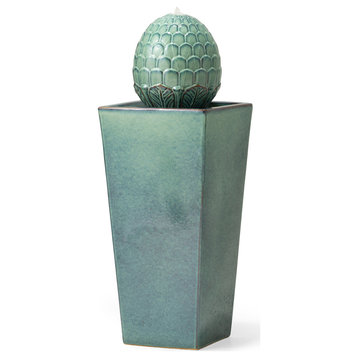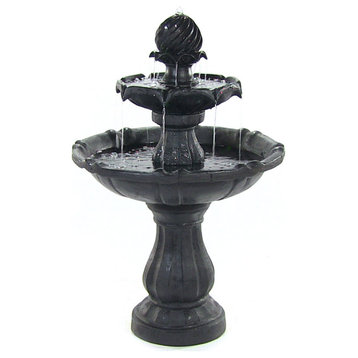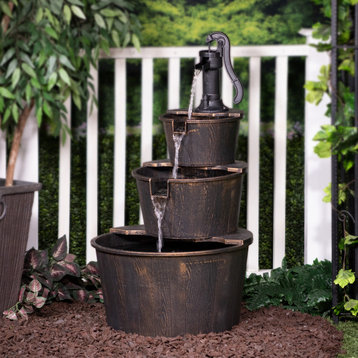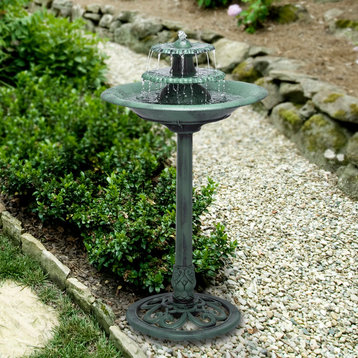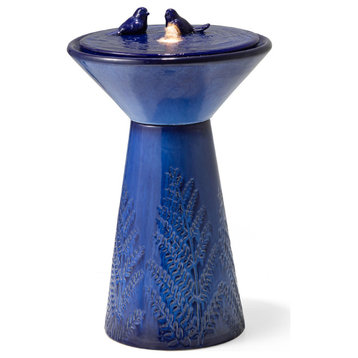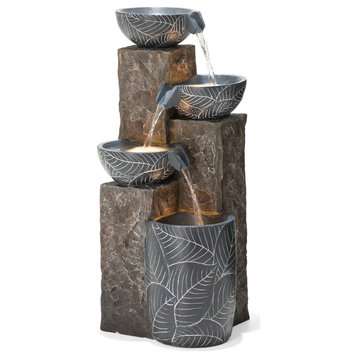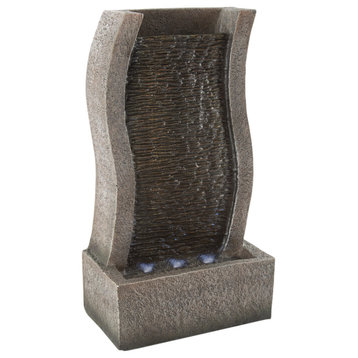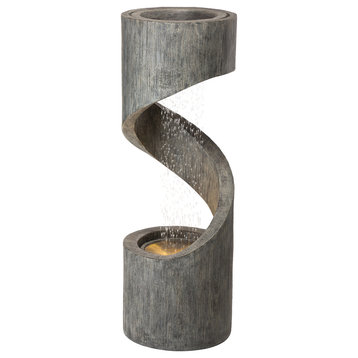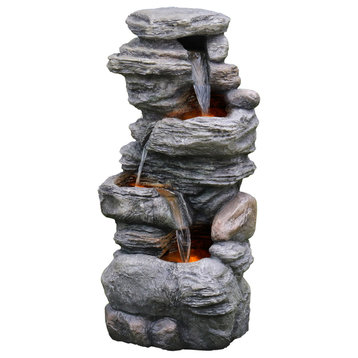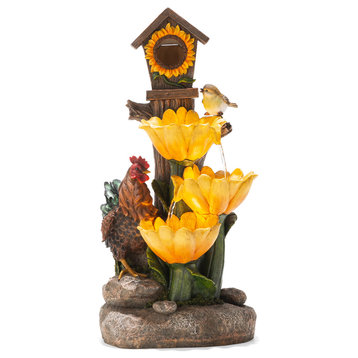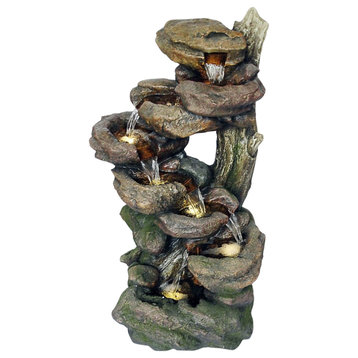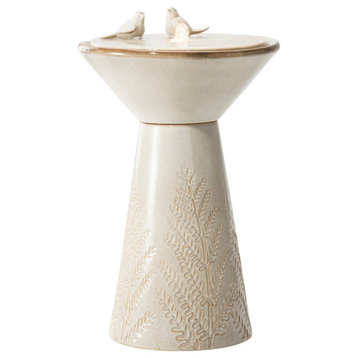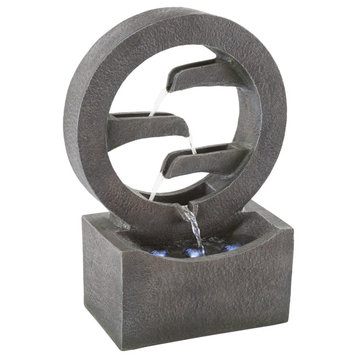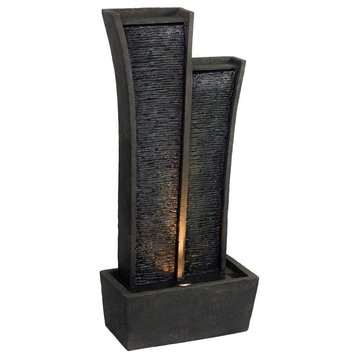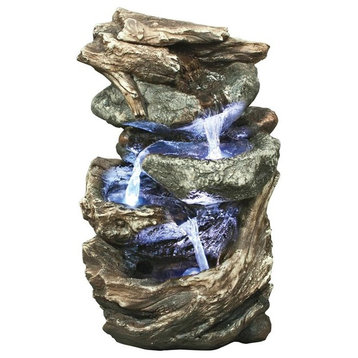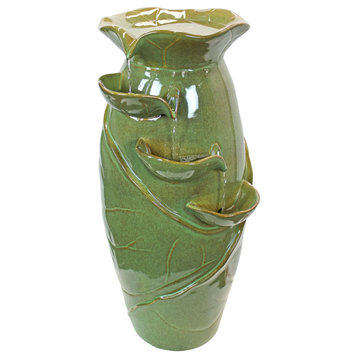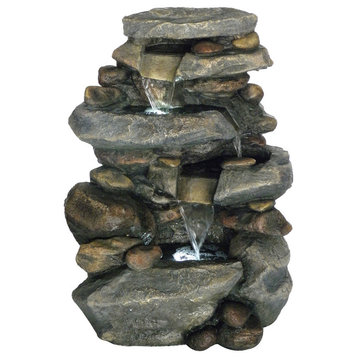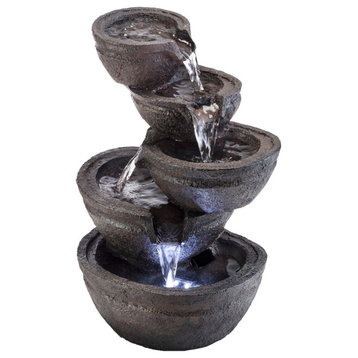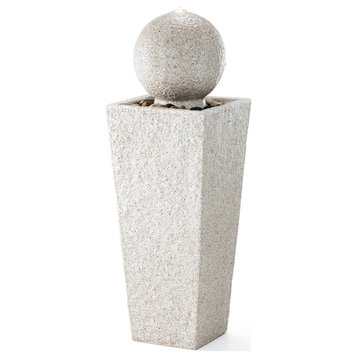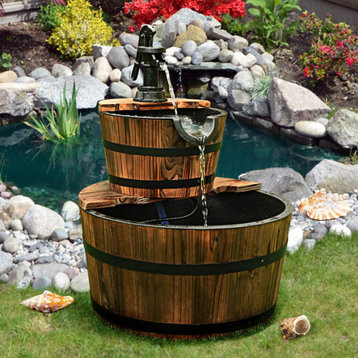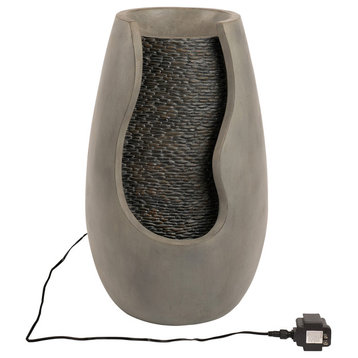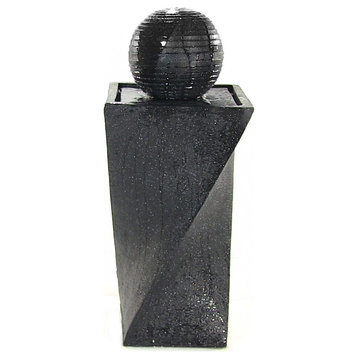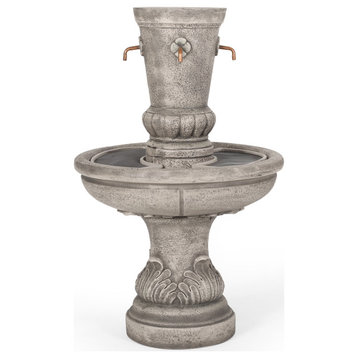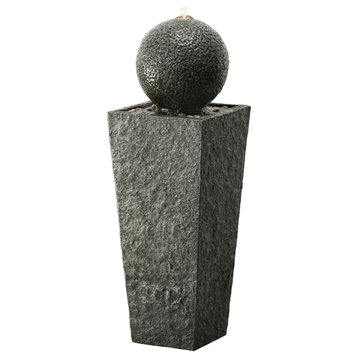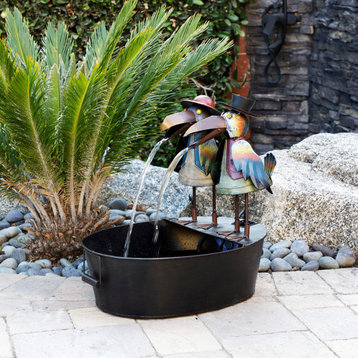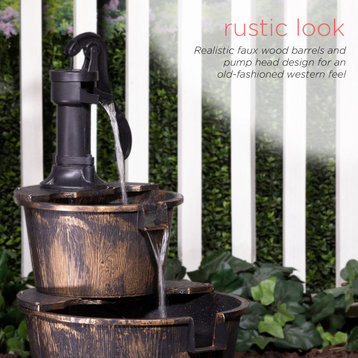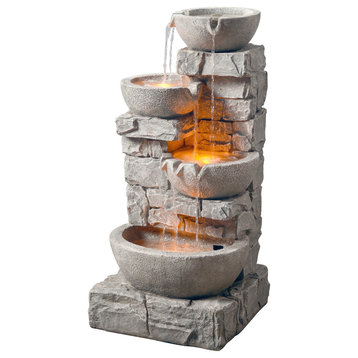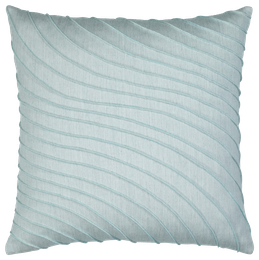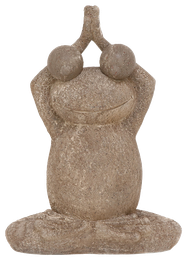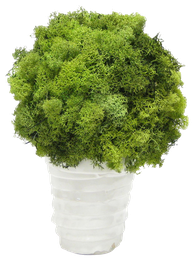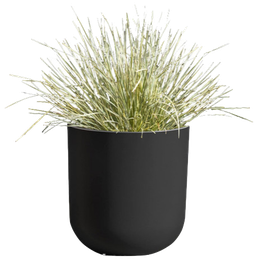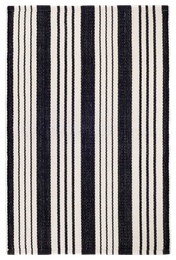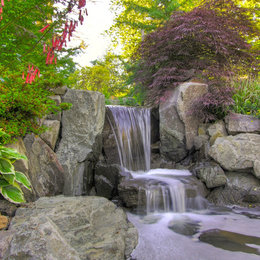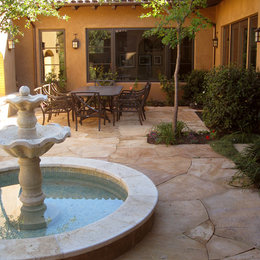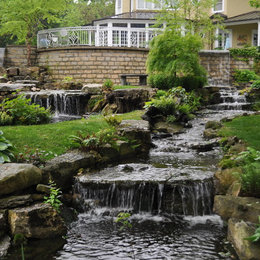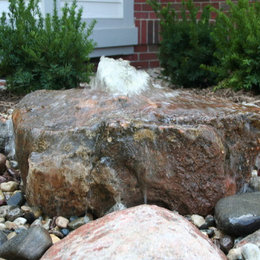FREE shipping on orders over $49!* Details
- All Products
- Outdoor
- Outdoor Decor
- Outdoor Fountains & Ponds
Outdoor Fountains and Ponds
Athena 38 inch Solar Fountain with LED Lightsby TEAMSON US INC(1)
$200
Free Shipping
Add a sleek, modern touch to your outdoor living spaces with Teamson Home's Athena Solar-Powered Outdoor Waterfall Fountain. This contemporary water feature's rainfall element at the top releases water onto the textured wall, where it trickles down to the pebble-covered base below. Illuminated by LED lights above the rainfall element and within the pebbles in the base below to create a unique visual experience. Includes a pump and the solar panel to angle for better sunlight exposure.
- Contemporary decorative waterfall fountain with a rainfall feature and textured surface
- LED lighting illuminate the rainfall above and up from among the pebbles in the base
- Solar-powered water pump and lighting included; solar panel includes an on/off button
- Becomes a focal point in landscaping, enhancing your home's curb appeal, or as a decorative piece on decks and patios
- Dimensions: 13.5" L x 8.74" W x 37.99" H; Capacity: 2.25 gal.
Outdoor 2-Tier Icy Stone Waterfall Fountainby TEAMSON US INC(31)
$269
Free Shipping
The Teamson Home Outdoor Icy Stone 2-Tier Water Fountain is a beautiful and relaxing addition to your outdoor space. Made of durable polyresin that is weatherproof and rust-resistant, a powerful pump creates a natural water flow that soothes senses that can help reduce stress and anxiety. Add as a decorative piece on your patio or deck, or place within your garden as a focal point in your landscaping. Popular classic pedestal style attracts birds and soft, Stone Gray finish blends with any decor.
- Popular classic pedestal style with two tiers in a Stone Gray finish
- Provides flowing water and a shallow basin for a vital source of clean water for birds to drink and bathe in
- Weatherproof, rust-resistant polyresin body becomes a focal point, a decorative piece in landscaping
- Includes an adjustable water pump with a 72.04" cord and suction cups for secure, submersed placement
- Dimensions: 24.21" dia. x 52.56" H; Water Capacity: 2.86 gallons
41" Tall Outdoor Tiering Column Zen Fountain With LED Lightsby Alpine Corporation(63)
$550
Free Shipping
SponsoredBring calming ambiance to your space with the Alpine Corporation Column Fountain. Set the mood for meditation or romance with this remarkable three-tier fountain. As water cascades from one column to the next, it makes soft sounds for ultimate relaxation. Each polyresin column has a rough texture that imitates natural, weathered stone. To use, simply plug into an outlet, fill lower basin with water, and watch as the interior pump with 6 ft. cord length, creates a lovely water flow. With a 1-year warranty, you can be confident in the quality of your purchase. Fountain measures 22"L x 19"W x 41"H for a perfect fit in your garden, patio, and more.
ZEN FOUNTAIN: 3-tier water fountain transforms your space into a restful oasis, and has an interior pump that keeps the water flowing - just plug it in!
RELAXING WATER FLOW: Water trickles from each tier to mimic the sounds of a small waterfall, adding ambiance to your patio, yard, garden, or anywhere you need to add a relaxing touch
NATURAL ELEMENTS: Weathered stone-like columns bring a touch of natural beauty to your space
ENERGY EFFICIENT AND DURABLE: Energy-saving design saves you money and is eco-friendly, while polyresin construction is rust- and weather-resistant to keep your outdoor fountain looking new over time
IDEAL SIZE: Fountain measures 22"L x 19"W x 41"H, the perfect size for any table or countertop in your home, and includes a one-year manufacturer's warranty from date of purchase
ZEN FOUNTAIN: 3-tier water fountain transforms your space into a restful oasis, and has an interior pump that keeps the water flowing - just plug it in!
RELAXING WATER FLOW: Water trickles from each tier to mimic the sounds of a small waterfall, adding ambiance to your patio, yard, garden, or anywhere you need to add a relaxing touch
NATURAL ELEMENTS: Weathered stone-like columns bring a touch of natural beauty to your space
ENERGY EFFICIENT AND DURABLE: Energy-saving design saves you money and is eco-friendly, while polyresin construction is rust- and weather-resistant to keep your outdoor fountain looking new over time
IDEAL SIZE: Fountain measures 22"L x 19"W x 41"H, the perfect size for any table or countertop in your home, and includes a one-year manufacturer's warranty from date of purchase
Jugs Fountain With Light, 23.5"by Santa's Workshop, Inc(4)
SALE
$175$341
Free Shipping
Relax to the comforting sound of flowing water as it slowly pours from jug to jug within this realistically rendered resin fountain. Crafted from long-lasting resin, this beautiful water fountain will make a perfect addition to your garden escape.
Lotus Leaf Fountain 19.5"H Ironby Melrose International LLC(4)
SALE
$94$156
Free Shipping
Decorate your home or garden with the beautiful Lotus Leaf Fountain this spring season. Great for both indoor and outdoor use, its sturdy metal construction is guaranteed to last through the years. Water drips from the tallest lotus flower onto the descending lily pads and pools in the pot at the base. The soothing sound of water will create a relaxing ambiance in your garden retreat. Featured in Melrose International's "Cottage Garden" collection.
- Measures 11.5x10.75x19.5
- Primary Materials: Iron Metal
- Reccommended for both indoor and outdoor use
Patina Resin Rectangular Outdoor Fountain with LED Lights and Bronze Birdsby LuxenHome(12)
$275
Free Shipping
SponsoredComplete your outdoor living space with this mid-century modern style fountain that artistically mixes vintage with nature. The patina finish of gray and green gives the fountain a natural enduring look. The bronze finish birds add to the charm and whimsy of the fountain. This outdoor rectangular pillar fountain will make a visually appealing focal point for your outdoor living space, patio, porch, deck, and garden. This water feature is an elegant and modern piece of outdoor decor that is sure to impress your guests. Enjoy the beauty of this fountain day and night, as the LED-illuminated lights shine on with the water playfully bubbling at the top.
Faux Granite Lion Head Polyresin Fountainby Glitzhome(1)
$237
Free Shipping
"Enhance your outdoor space with this classic European lion head sculpture fountain. It featured with faux granite embossed texture adds a touch of artistic and natural beauty. The 3-tier design creates vivid waterfall, water running and spilling into the pool, the soothing sound of cascading water helps to create a relaxing and meditative atmosphere. It has a warm white LED light inside of the bottom basin, the trickling water rippled and sparkled in the warm glowing light at night adds visual interest, which is sure to convert your space into a tranquil, romantic, charming and pleasing environment. Constructed of high quality polyresin and stone powder, very sturdy and durable. A convenient power cord and pump are included, simply add water, plug in and enjoy!
- Elegant and timeless European design with embossed lion head.
- Faux granite embossed texture adds a touch of natural beauty and artistic to your space.
- 3-Tier design creates vivid waterfall, water cascading from one basin to another that looks vivid and interesting.
- The trickling water rippled and sparkled in the warm white LED light adds visual interest.
- The soothing sound of cascading water creates a relaxing atmosphere.
- Constructed of high quality polyresin and stone powder, very sturday and durable, easy to storage and move.
- Crafted with mold slip casting and hand painted.
- Built-in 12V UL Listed or ETL Listed Pump and Adapter
- 110V~120V 60HZ, US plugs, 6 ft power cord.
- Water Capacity: 3 Gallon
- Max. Flow Rate: 113.5 GPH
- LED: 0.5~0.8W
- One - year manufacturer warranty.
- For outdoor use. During freezing temperatures, please drain the fountain, disconnect the pump, and store indoors."
Frontage Outdoor 2-Tier Single Spout Fountain, Light Grayby GDFStudio
$209
Free Shipping
Close your eyes and enjoy the soothing sounds of flowing water right from your own backyard. Our garden fountain features a calm waterfall flow that continuously circulates using an included pump, bringing a classic look to any backyard or patio. Crafted with an incredibly durable polyresin material, this decorative accessory offers a weather-resistant structure that allows outstanding attention to detail. Finished with a classic single spout and two-tier design and enchanting underwater lights, our water fountain is sure to add a touch of whimsy to your home.
A TOUCH OF PERSONALITY: Easily customize your backyard, garden, or patio with this charming outdoor water fountain. With a classic design and stunning attention to detail, this accessory will be sure to enhance any outdoor space.
WATERFALL FLOW: With a gentle and relaxing water flow, this garden fountain uses an interior pump to bring a peaceful atmosphere to your outdoor space. This fountain features a classic single spout and two-tier design that creates a beautiful waterfall effect.
FAUX STONE: Crafted with a stone-like material, this fountain provides a weather-resistant foundation that has clean-cut edges. This can be easily poured into flexible molds that brings outstanding details to each piece.
LED LIGHTS: The top of this fountain is illuminated with underwater LED lights for a dynamic effect on your outdoor decor. These lights offer an eco-friendly, energy-efficient option that saves you electricity and money. These lights have an incredibly long life span and do not burn out like regular bulbs. They will simply begin to dim once it begins to lose its energy.
DIMENSIONS: Choose an accessory that is the perfect size for you and your furniture. This fountain is 19.60" W x 12.50" D x 34.50" H. You will love how much your space can transform with the simple addition of this charming fountain.
A TOUCH OF PERSONALITY: Easily customize your backyard, garden, or patio with this charming outdoor water fountain. With a classic design and stunning attention to detail, this accessory will be sure to enhance any outdoor space.
WATERFALL FLOW: With a gentle and relaxing water flow, this garden fountain uses an interior pump to bring a peaceful atmosphere to your outdoor space. This fountain features a classic single spout and two-tier design that creates a beautiful waterfall effect.
FAUX STONE: Crafted with a stone-like material, this fountain provides a weather-resistant foundation that has clean-cut edges. This can be easily poured into flexible molds that brings outstanding details to each piece.
LED LIGHTS: The top of this fountain is illuminated with underwater LED lights for a dynamic effect on your outdoor decor. These lights offer an eco-friendly, energy-efficient option that saves you electricity and money. These lights have an incredibly long life span and do not burn out like regular bulbs. They will simply begin to dim once it begins to lose its energy.
DIMENSIONS: Choose an accessory that is the perfect size for you and your furniture. This fountain is 19.60" W x 12.50" D x 34.50" H. You will love how much your space can transform with the simple addition of this charming fountain.
- Includes: One (1) Fountain
- Material: Faux Stone
- Finish: Light Gray
- Light Type: LED
Hand-Crafted Details
- Assembly Required
- Dimensions: 12.50 inches deep x 19.60 inches wide x 35.50 inches high
Tabletop Water Fountain With Cascading Rock Waterfall and LED Lightsby Pure Garden(601)
SALE
$54$91
Free Shipping
The soothing water sounds, realistic looking stone, and lighting ambiance of the Tiered Rock Fountain by Pure Garden brings tranquility, relaxation, and the beauty of nature to your living or working area. The fountain features a polyresin construction for durability, LED lights, included pump with maximum flow of 42 gallons per hour, and is easy to set up for low stress assembly. Whether you use this fountain as decoration on a desk in your office, or on a tabletop in your home or patio, this lighted fountain is sure to bring an environment of peace and serenity, while leaving an elegant lasting impression!
IMPORTANT: Avoid buying counterfeit products and transacting with unauthorized sellers. Look for our logo on the packaging for every one of our products. Pure Garden is committed to providing the consumer with the absolute best price and value on our entire line of products, which we ensure by applying a rigorous Quality Control process.
UNIQUE DECOR WITH LED LIGHTING- This 4 tiered fountain is truly an ideal blend of modern design, zen elements, and nature-inspired charm, and it offers the tranquil and meditative sounds of running waters for a calming ambiance. The fountain is lit by LED lights to help to illuminate the waters and offer a peaceful, relaxing glow. With the water gently cascading over the artistically fashioned stone tiers, the water fountain is sure to be a vivid focal point in your bedroom, living room, home, office or even outdoors on a table on your patio!
DURABLE DESIGN - Enjoy your house, work or deck decor without worry. Made from sturdy polyresin material, this fountain is lightweight and durable for longer lasting use
LOW MAINTENANCE AND EASY SET UP- Pure Garden water fountains require no additional plumbing, stressful setup, or upkeep. Including a UL listed pump with 42 gallons per hour maximum flow, all you need to do after assembly is fill it with the proper amount of water, and plug it in to a standard electrical outlet, and you are ready to enjoy the delightful sounds of nature.
PRODUCT DETAILS - Fountain dimensions: 15.5" H x 10.5" W x 7.5" L. Material: Polyresin. Weatherproof. Pump Included. Adjustable Valve. Voltage: V. Wattage: 2W. Certifications and Listings: UL. Prelit: 3 LED lights. Cord Length: 59"
SATISFACTION GUARANTEED- Pure Garden is committed to providing consumers with the absolute best price and value on our entire line of products. NOTE: This is an exclusive product of Pure Garden and ONLY The Tabletop Rock Water Fountain with LED Lights by Pure Garden are GUARANTEED to be genuine
IMPORTANT: Avoid buying counterfeit products and transacting with unauthorized sellers. Look for our logo on the packaging for every one of our products. Pure Garden is committed to providing the consumer with the absolute best price and value on our entire line of products, which we ensure by applying a rigorous Quality Control process.
UNIQUE DECOR WITH LED LIGHTING- This 4 tiered fountain is truly an ideal blend of modern design, zen elements, and nature-inspired charm, and it offers the tranquil and meditative sounds of running waters for a calming ambiance. The fountain is lit by LED lights to help to illuminate the waters and offer a peaceful, relaxing glow. With the water gently cascading over the artistically fashioned stone tiers, the water fountain is sure to be a vivid focal point in your bedroom, living room, home, office or even outdoors on a table on your patio!
DURABLE DESIGN - Enjoy your house, work or deck decor without worry. Made from sturdy polyresin material, this fountain is lightweight and durable for longer lasting use
LOW MAINTENANCE AND EASY SET UP- Pure Garden water fountains require no additional plumbing, stressful setup, or upkeep. Including a UL listed pump with 42 gallons per hour maximum flow, all you need to do after assembly is fill it with the proper amount of water, and plug it in to a standard electrical outlet, and you are ready to enjoy the delightful sounds of nature.
PRODUCT DETAILS - Fountain dimensions: 15.5" H x 10.5" W x 7.5" L. Material: Polyresin. Weatherproof. Pump Included. Adjustable Valve. Voltage: V. Wattage: 2W. Certifications and Listings: UL. Prelit: 3 LED lights. Cord Length: 59"
SATISFACTION GUARANTEED- Pure Garden is committed to providing consumers with the absolute best price and value on our entire line of products. NOTE: This is an exclusive product of Pure Garden and ONLY The Tabletop Rock Water Fountain with LED Lights by Pure Garden are GUARANTEED to be genuine
Artichoke Pedestal Ceramic Fountainby Glitzhome(1)
$224
Free Shipping
This stylish and minimalist fountain featured with geometric pedestal and artichoke elements, as well as the elegant and charming kiln-fired turquoise glaze finish, brings a touch of artistic and natural beauty to your space. Water bubbling up, over the orb, and spilling into a shallow pool below, the soothing sound of cascading water helps to create a relaxing and meditative atmosphere. A warm white LED light above the sphere, the trickling water rippled and sparkled in the warm glowing light adds visual interest, which is sure to convert your garden into a tranquil, charming and pleasing environment. This versatile fountain will be a delightful addition to any of your garden, patio, deck, porch or home space. A convenient power cord and pump are included, simply adds water, plug in and enjoy!
- Featured with classical artichoke element design.
- Elegant and charming kiln-fired turquoise glaze finish.
- The trickling water rippled and sparkled in the warm white LED light.
- The soothing sound of cascading water is sure to relax you after a long day.
- Made of 100% ceramic, anti-rust and weather-resistant.
- Built-in 12V UL Listed pump & adapter.
- 110V~120V 60HZ, US plug, 6 ft power cord.
- Water Capacity: 0.66 Gallon
- Max. Flow Rate: 113.5 GPH
- LED: 0.5~0.8W
- One - year manufacturer warranty.
- For outdoor use, the temperature needs above 0.
Sunnydaze 2-Tier Outdoor Water Fountain, Solar-on-Demand, Black, 35"by Sunnydaze Decor(667)
SALE
$299$359
Free Shipping
This birdbath is perfect for your garden or landscaped area with no need for an outlet! It can run on solar and battery back-up power. In prime sunlight conditions, the pump will be powered by solar energy while the solar panel will also recharge the batteries. To run on battery mode simply press the Battery On/Off button. The battery will now power the pump. On the battery mode it can run for up to 4 hrs on cloudy days or at night. When the battery power is depleted, the system will automatically change back to solar powered mode and start again when there is sufficient sunlight. A fully charged battery will operate up to 4 hours after the sun goes down. You can operate it daily using the battery technology for consistent performance even in cloudy conditions, or leave your fountain off, charging the batteries for use when you want it.
40" Tall Outdoor 3-Tier Barrel Pump Waterfall Fountain, Brownby Alpine Corporation(1226)
$151
Free Shipping
Add a touch of vintage fun to your outdoor space with the Alpine Corporation Pump and Barrel Fountain. Enjoy the sound of trickling water that pours from the pump spout, down through the three layers of barrel buckets. The design adds an old-fashioned rustic element to your space. This outdoor fountain looks great in your garden, patio, deck, porch, or yard space. The plastic construction is weather-proof, rust-resistant, and durable for years of quality use. The weight of the fountain and sturdy base allow it to stay upright in the strongest wind. To use, simply plug it into an outdoor outlet, fill upper level with water, and watch as the interior pump creates a lovely water flow. The cord is 6 feet long, giving you plenty of options for placement. With a 1-year warranty, you can be confident in the quality of your purchase. Fountain measures 22"L x 25"W x 40"H for use in yards of any size. Individual bucket depths are: Small 6.4"D / Medium 8.4"D / Large 11.75"D. Alpine Corporation is one of America's leading designers, importers, and distributors of superior quality home and garden decor products. Alpine Corporation's award winning in-house design team continuously develops new and innovative "statement pieces" for your home and garden. Your indoor and outdoor living spaces will be the envy of the neighborhood with our wide assortment of fresh, fashionable and contemporary products, from beautifully crafted solar garden stakes featuring patented motion and fiber optic lighting technology to beautiful fountains and delightful bird baths and feeders.
35" Tall Outdoor 3-Tiered Pedestal Water Fountain and Birdbath, Greenby Alpine Corporation(4499)
SALE
$64$95
Free Shipping
SponsoredBeckon feathered friends to your yard with the Alpine Corporation Tiered Pedestal Water Fountain and Birdbath. Fill the bath with fresh water and enjoy watching all the birds congregate near your patio, garden, deck, yard, or pool! This high-quality birdbath features a rustic green color with an antique finish — great for adding a pop of color to your outdoor décor. It is perfect for pairing with a bird feeder to coax a variety of birds outside your window during any season. The soothing water flow across the three tiers will help you relax and enjoy the outdoors on a nice summer day. The sturdy pedestal keeps the birdbath from tipping over while the resin construction withstands weather changes. Your yard will be the delight of humans and winged creatures alike! With a 1-year warranty, you can be confident in the quality of your purchase. Birdbath measures 20"L x 20"W x 35"H for use in yards of any size. Alpine Corporation is one of America's leading designers, importers, and distributors of superior quality home and garden decor products. Alpine Corporation's award winning in-house design team continuously develops new and innovative "statement pieces" for your home and garden. Your indoor and outdoor living spaces will be the envy of the neighborhood with our wide assortment of fresh, fashionable and contemporary products, from beautifully crafted solar garden stakes featuring patented motion and fiber optic lighting technology to beautiful fountains and delightful bird baths and feeders.
Cobalt Plant Pattern Pedestal Ceramic Fountainby Glitzhome
$219
Free Shipping
This chic and interesting ceramic fountain featured with delicate embossed plant texture and two cute lively birds, as well as the elegant and charming kiln-fired cobalt blue glaze finish with antique details that brings a touch of artistic and natural beauty to your space. Water bubbling and spilling into the pool, the soothing sound of cascading water helps to create a relaxing and meditative atmosphere. It has a warm white LED light, the trickling water rippled and sparkled in the warm glowing light adds visual interest, which is sure to convert your space into a tranquil, romantic, charming and pleasing environment. This versatile fountain will be a warm and delightful addition to any of your garden, patio, deck, porch or home space. A convenient power cord and pump are included, simply adds water, plug in and enjoy!
- Featured with delicate embossed plant texture and two cute lively birds.
- Elegant and charming kiln-fired cobalt blue glaze finish with antique details.
- The trickling water rippled and sparkled in the warm white LED light.
- The soothing sound of cascading water is sure to relax you after a long day.
- Made of 100% ceramic, anti-rust and weather-resistant.
- Built-in 12V UL Listed pump & adapter.
- 110V~120V 60HZ, US plug, 6 ft power cord.
- Water Capacity: 0.75 Gallon
- Max. Flow Rate: 113.5 GPH
- LED: 0.5~0.8W
- One - year manufacturer warranty.
- For outdoor use, the temperature needs above 0.
Natural Leaf Textured 4-Tier Resin Fountainby Glitzhome
$253
Free Shipping
Creates a calming oasis and brings a touch of artistic to your space with this stylish and classical oversized 4-tier resin fountain. It features natural and delicate embossed leaves texture as well as the interesting stacked design that brings a touch of artistic and natural beauty to your space. The stacked design lets water come to life that looks vivid and interesting. Water cascading down through one basin and spilling into another, the soothing sound of cascading water helps to create a relaxing and meditative atmosphere. Each tier has a warm white LED light, the trickling water rippled and sparkled in the warm glowing light adds visual interest, which is sure to convert your space into a tranquil, charming and pleasing environment. This versatile fountain will be a delightful addition to any of your garden, patio, deck, porch or home space. A convenient power cord and pump are included, simply adds water, plug in and enjoy!
- Oversized, interesting 4-tier stacked design accents natural and delicate embossed leaves texture.
- The soothing sound of cascading water helps to create a relaxing and meditative atmosphere.
- The trickling water rippled and sparkled in the warm glowing light adds visual interest.
- Constructed of high quality polyresin and stone powder, light weight, anti-rust and weather-resistant.
- Built-in 12V UL Listed pump & adapter.
- 110V~120V 60HZ, US plug, 6 ft power cord.
- Water Capacity: 4.9 Gallon
- Max. Flow Rate: 172.8 GPH
- LED: 0.5~0.8W
- One - year manufacturer warranty.
- For outdoor use, the temperature needs above 0��.
Pure Garden Freestanding Stone Wall Fountainby Pure Garden(73)
SALE
$89$124
Free Shipping
Create a calming backyard, deck, or patio oasis with this Freestanding Stone Wall Fountain by Pure Garden. Made from durable polyresin to resist inclement weather and corrosion from circulating water, this outdoor waterfall fountain features a curved, contemporary design that's hand-painted silver for a unique look that meshes well with most exterior color schemes. A recirculation pump provides continuous water flow, while three LED lights on the bottom tier glow softly for a relaxing nighttime ambiance.
IMPORTANT: Pure Garden is committed to providing the consumer with the absolute best price and value on our entire line of products. NOTE: This is an exclusive product of Pure Garden and ONLY Freestanding Stone Wall Fountain by Pure Garden are GUARANTEED to be genuine. Avoid buying counterfeit products and transacting with unauthorized sellers.
The hand-painted finish lends individual character to this waterfall fountain and meshes marvelously with numerous interior and exterior design palettes
Construction from sturdy polyresin ensures this freestanding waterfall fountain resists rust and corrosion and withstands the rigors of inclement weather
IMPORTANT: Pure Garden is committed to providing the consumer with the absolute best price and value on our entire line of products. NOTE: This is an exclusive product of Pure Garden and ONLY Freestanding Stone Wall Fountain by Pure Garden are GUARANTEED to be genuine. Avoid buying counterfeit products and transacting with unauthorized sellers.
- Dimensions: Fountain: (L) 6.25 x (W) 10.5 x (H) 19-inches; Cord: (L) 10-feet; Weight: 7.7lbs
- Materials: Polyresin
The hand-painted finish lends individual character to this waterfall fountain and meshes marvelously with numerous interior and exterior design palettes
Construction from sturdy polyresin ensures this freestanding waterfall fountain resists rust and corrosion and withstands the rigors of inclement weather
- A high-capacity fountain basin and included recirculation pump let you revel in the calming sounds of cascading water uninterrupted
- Color: Silver
40"H Curving Shaped Outdoor Polyresin Gray Fountain With LED Light and Pumpby Glitzhome(237)
SALE
$310$348
Free Shipping
This oversized modern and minimalist outdoor fountain inspired by spiral design combined with streamlined falling water, featured with faux granite texture and terrazzo looking, brings a touch of artistic and natural beauty to your space. The soothing rainfall sound helps to create a relaxing and meditative atmosphere. There is an warm white LED light in the bottom, the streamlined falling water rippled and sparkled in the warm glowing light adds visual interest, which is sure to convert your garden, patio or backyard into a tranquil, charming and pleasing environment. Constructed of high quality polyresin and stone powder, very sturdy and durable. A convenient power cord and pump are included, simply add water, plug in and enjoy!
- Oversized modern and minimalist spiral design combined with streamlined falling water provide an aesthetic.
- Faux granite texture with imitation concrete looking.
- The soothing rainfall sound helps to create a relaxing and meditative atmosphere.
- The streamlined falling water rippled and sparkled in the warm glowing light adds visual interest.
- Crafted of high quality polyresin and stone powder, very sturdy and durable, easy to move and storage.
- Crafted with mold slip casting and hand painted.
- Built-in UL/ETL Listed pump & adapter.
- 110V~120V 60HZ, US plugs, 6ft power cord.
- Water Capacity: 3.7 Gallon
- Max. Flow Rate: 225.5 GPH
- LED: 0.5~0.8W
- One - year manufacturer warranty
- Weight Capacity for the top: 1.5kgs (3.3LBS)
- For outdoor use. During freezing temperatures, please drain the fountain, disconnect the pump, and store indoors.
40" 3 Tier Rock Water Fountain with LED Lightby TEAMSON US INC(18)
$306
Free Shipping
Teamson Home 4-Tier Stone-Look Waterfall Fountain with LED Lights adds a touch of tranquility and beauty to your outdoor living spaces. Made of durable polyresin and stone powder to withstand the weather and rust, its faux Schist stone look is a rustic addition to any porch, patio, deck, or landscaping. A trio of built-in LED lights have an orange tint creating a warm glow. Includes a 600 L/H pump that continuously keeps the water circulating and a 72" power cord.
- Rustic faux schist stone, stacked in four tiers, with grainy details
- Built-in LED lights for an energy-efficient soft warm orange glow
- Weatherproof, rust-resistant polyresin body becomes a focal point, a decorative piece in landscaping
- Includes an adjustable water pump with a 72.04" cord, and suction cups for secure, submersed placement
- Dimensions: 18.11" L x 12.99" W x 39.37" H; Water Capacity: 6.6 gallons
Sunflowers and Birdhouse Resin Outdoor Fountainby Glitzhome
$187
Free Shipping
Creates a calming oasis and brings a touch of artistic to your space with this farmhouse sunflowers and birdhouse resin fountain. It featured with interesting and vivid sunflowers, birdhouse, rooster that brings a touch of natural beauty and adds rustic charm to your space. The stacked design lets water come to life that looks vivid and interesting. Water cascading down through one flower and spilling into another, the soothing sound of cascading water helps to create a relaxing and meditative atmosphere. Each tier has a warm white LED light, the trickling water rippled and sparkled in the warm glowing light adds visual interest, which is sure to convert your space into a tranquil, charming and pleasing environment. This versatile fountain will be a delightful addition to any of your garden, patio, deck, porch or home space. A convenient power cord and pump are included, simply adds water, plug in and enjoy!
- Interesting and vivid birdhouse and sunflowers decoration adds a touch of rustic charm.
- The soothing sound of cascading water helps to create a relaxing and meditative atmosphere.
- The trickling water rippled and sparkled in the warm glowing light adds visual interest.
- Constructed of high quality polyresin and stone powder, light weight, anti-rust and weather-resistant.
- Built-in 12V UL Listed pump & adapter.
- 110V~120V 60HZ, US plug, 6 ft power cord.
- Water Capacity: 2 Gallon
- Max. Flow Rate: 63.3 GPH
- LED: 0.5~0.8W
- One - year manufacturer warranty.
- For outdoor use, the temperature needs above 0��.
Rainforest 5-Tier Cascading Fountain with LED Lightby Alpine Corporation(15)
$97
Free Shipping
SponsoredCreate a peaceful/ meditative atmosphere even in an urban jungle as you rejuvenate with our natural style fountains. You will feel like you are sitting next to a majestic mountain stream in the great outdoors all while relaxing in your own lush garden. The sound of birds frolicking to the running water will create the tranquil environment of everyone's envy. With the water gently cascading over natural-looking stone/ Alpines cascading fountain is sure to be a vivid focal point to your outdoor Decor.
Fern Fronds Pattern Pedestal Fountainby Glitzhome
$230
Free Shipping
"This chic and interesting ceramic fountain featured with delicate embossed fern fronds texture and two cute lively birds, as well as the elegant and charming kiln-fired sand beige glaze finish with antique details that brings a touch of artistic and natural beauty to your space. Water bubbling and spilling into the pool, the soothing sound of cascading water helps to create a relaxing and meditative atmosphere. It has a warm white LED light, the trickling water rippled and sparkled in the warm glowing light adds visual interest, which is sure to convert your space into a tranquil, romantic, charming and pleasing environment. This versatile fountain will be a warm and delightful addition to any of your garden, patio, deck, porch or home space. A convenient power cord and pump are included, simply adds water, plug in and enjoy!
- Elegant and delicate embossed plant texture adds a touch of artistic.
- Two cute and lively birds ftolicking at the edge of the top basin looks vivid and interesting.
- Elegant and charming kiln-fired glossy sand beige glaze finish.
- The trickling water rippled and sparkled in the warm white LED light adds visual interest.
- The soothing sound of cascading water creates a tranquil ambiance.
- Made of 100% ceramic, anti-rust and weather-resistant.
- Built-in 12V UL Listed or ETL Listed Pump and Adapter
- 110V~120V 60HZ, US plugs, 6 ft power cord.
- Water Capacity: 0.75 Gallon
- Max. Flow Rate: 113.5 GPH
- LED: 0.5~0.8W
- One - year manufacturer warranty.
- For outdoor use. During freezing temperatures, please drain the fountain, disconnect the pump, and store indoors."
Pure Garden Round Cascade Fountain With 4 Tier Polyresin Waterfall, LED Lightsby Pure Garden(110)
SALE
$83$100
Free Shipping
Create your own calming backyard oasis with the freestanding Round Cascade Fountain by Pure Garden. This outdoor water feature is made of durable polyresin to resist the elements and corrosion from circulating water. The fountain is hand painted for a unique look and has a circular contemporary design that is sure to complement almost any backyard decor. The fountain includes a recirculation pump for continuous water flow and features 3 LED lights on the bottom tier that provide a soft, warm glow so you can enjoy a relaxing atmosphere. The fountain easily sets up in minutes and is powered by a 10' wall outlet cord so it can be placed almost anywhere on your deck, patio or in your backyard.
SATISFACTION GUARANTEED- Pure Garden is committed to providing the consumer with the absolute best price and value on our entire line of products, which we ensure by applying a rigorous quality control process.
NOTE: This is an exclusive product of Pure Garden and ONLY Round Cascade Fountains by Pure Garden are GUARANTEED to be genuine.
IMPORTANT: Avoid buying counterfeit products and transacting with unauthorized sellers. Look for our logo on the packaging for every one of our products.
SATISFACTION GUARANTEED- Pure Garden is committed to providing the consumer with the absolute best price and value on our entire line of products, which we ensure by applying a rigorous quality control process.
NOTE: This is an exclusive product of Pure Garden and ONLY Round Cascade Fountains by Pure Garden are GUARANTEED to be genuine.
IMPORTANT: Avoid buying counterfeit products and transacting with unauthorized sellers. Look for our logo on the packaging for every one of our products.
- Dimensions: (L) 7" x (W) 11" x (H) 18.5"
- Materials: Polyresin
- Catch basin has 3 LED lights that provide a soft, warm glow so you can enjoy your fountain, day or night
- Includes an electric recirculation pump designed for continuous water flow, so you can enjoy the fountain's calming sounds, uninterrupted
- Color: Gray
41.50" Indoor/Outdoor Fountain With Lightby Ore International
$280
Free Shipping
- Adjustable intensity
- One light
- Large fountain
- Item Length: 18
- Item Width: 10.25
- Item Height: 41
- Item Weight: 32.5
- Color: Multicolor
- Materials: Polyresin
- Extra Tools Needed: No
Glacier Peak Cascading Garden Fountainby Design Toscano(146)
SALE
$49$66
You'll be hard pressed to find a more naturalistic garden fountain than this amazingly detailed, nearly yard-tall work of functional garden art! Tranquil water cascades across three levels of weathered stones and time-honored tree branches to empty gently into a softly illuminated pool. Cast in quality designer resin and realistically hand-painted to capture the patinas of aged wood and moss-covered rocks, this Design Toscano-exclusive work creates an instantly peaceful garden sanctuary with an integrated, UL-listed, indoor/outdoor pump and low-voltage LED lights for dramatic effect.
6"Wx5"Dx10"H. 4 lbs.
6"Wx5"Dx10"H. 4 lbs.
Ceramic Cascading Vines Garden Fountainby Design Toscano(151)
$284
Free Shipping
Enjoy the beautiful water music of a ceramic fountain with a big time sound! Water bubbles and flows from the expertly sculpted leaves of our quality ceramic Vine Jar Fountain, hand fired in an extreme heat kiln, once for stability and then again, with a special glaze that creates a one-of-a-kind, smooth, glossy, waterproof finish. You'll delight at hearing the cascading water falling into the generous ceramic basin to create an in-home meditative atmosphere. Our Design Toscano fountain features integrated, UL-listed, indoor/outdoor pump. Bring inside during freezing temperatures.
LED Lighted Waterfall Fountain with Pump by Pure Gardenby Pure Garden(570)
SALE
$202$344
Free Shipping
- This water fountain is an ideal blend of contemporary design with old-world sculpture.
- With its rustic charm, this water fountain will be the center of attention wherever you place it.
Product Features:
Fountain Info:
- Material: Polyresin
- Number of Tiers: 3
- Weatherproof: Yes
- Indoor/Outdoor Use: Outdoor
- Pump Included: Yes
- Pre-Lit: 2 LED Lights
- Dimensions: 19.4" L x 15" W x 25.5" H
Pump Info:
- Adjustable Valve: Yes
- Cord Length: 118"
- Required Tubing
- Diameter: 0.5"
- Voltage: 120V
- Amperage: 0.083A
- Certifications and Listings: UL
- Wattage: 6W
- Maximum Flow: 120 gph
13" Tall Indoor/Outdoor Tabletop Tiering Bowls Fountain With LED Lightsby Alpine Corporation(234)
SALE
$91$158
Free Shipping
SponsoredBring calming ambiance to your space with the Alpine Corporation 13" Tall Indoor/Outdoor Tiering Bowls Tabletop Fountain with LED Lights. Set the mood for meditation or romance with this remarkable five-tier fountain. As water cascades from one bowl to the next, it makes soft sounds for ultimate relaxation. Each polyresin bowl has a rough texture that imitates natural, weathered stone. LED lighting in the bottom layer provides a subtle and intimate light source in your space. To use, simply plug into an outlet, fill lower basin with water, and watch as the interior pump creates a lovely water flow. With a 1-year warranty, you can be confident in the quality of your purchase. Fountain measures 9"L x 7"W x 13"H for a perfect fit in your office, bedroom, living room, hall, kitchen, and more.
INDOOR/OUTDOOR ZEN FOUNTAIN: 5-tier water fountain transforms your space into a restful oasis and the interior pump keeps the water flowing - just plug it in!
RELAXING WATER FLOW: Water cascades from each tier to mimic the sounds of a small waterfall, adding ambiance to your living room, office, bedroom, or anywhere you need to add a relaxing touch
NATURAL ELEMENTS: Weathered stone-like bowls bring a touch of natural beauty to your space
ROMANTIC LIGHTING: LED lights are integrated in the bottom tier of the fountain for an intimate lighting source that draws attention to the relaxing water flow
IDEAL SIZE: Fountain measures 9"L x 7"W x 13"H, the perfect size for any table or countertop in your home, and includes a one-year manufacturer's warranty from date of purchase
INDOOR/OUTDOOR ZEN FOUNTAIN: 5-tier water fountain transforms your space into a restful oasis and the interior pump keeps the water flowing - just plug it in!
RELAXING WATER FLOW: Water cascades from each tier to mimic the sounds of a small waterfall, adding ambiance to your living room, office, bedroom, or anywhere you need to add a relaxing touch
NATURAL ELEMENTS: Weathered stone-like bowls bring a touch of natural beauty to your space
ROMANTIC LIGHTING: LED lights are integrated in the bottom tier of the fountain for an intimate lighting source that draws attention to the relaxing water flow
IDEAL SIZE: Fountain measures 9"L x 7"W x 13"H, the perfect size for any table or countertop in your home, and includes a one-year manufacturer's warranty from date of purchase
Faux Terrazzo Polyresin Outdoor Fountainby Glitzhome
$273
Free Shipping
"This oversized modern and minimalist pedestal and sphere geometric design with faux granite texture and terrazzo looking brings a touch of artistic and natural beauty to your space. It will enhance your garden, patio or backyard. Water bubbling up, over the orb, and spilling into a shallow pool below with pebbles. The soothing sound of cascading water helps to create a relaxing and meditative atmosphere. An LED light above the sphere, the trickling water rippled and sparkled in the warm glowing light adds visual interest, which is sure to convert your garden into a tranquil, charming and pleasing environment. Constructed of high quality polyresin and stone powder, very sturdy and durable. A convenient power cord and pump are included, simply add water, plug in and enjoy!
- Oversized Minimalist Geometric design: Oversized minimalist geometric design, perfect for any modern or zen style garden.
- Faux granite texture and terrazzo looking brings natural beauty to your space.
- The trickling water rippled and sparkled in the warm glowing light adds visual interest.
- The soothing rainfall sound helps to create a tranquil ambiance.
- Constructed of high quality polyresin and stone powder, very sturday and durable, easy to storage and move.
- Crafted with mold slip casting and hand painted.
- Built-in 12V UL Listed or ETL Listed Pump and Adapter.
- 110V~120V 60HZ, US plugs, 6ft power cord.
- Water Capacity: 2 Gallon.
- Max. Flow Rate: 113.5 GPH.
- LED: 0.5~0.8W
- One - year manufacturer warranty.
- For outdoor use. During freezing temperatures, please drain the fountain, disconnect the pump, and store indoors."
3 Gallons 23" Decorative 2-Tier Wood Wine Barrel Fountain with Adjustable Pump, Medium #Pl50066by Home Garden Collections(7)
$95
Free Shipping
- This garden water fountain features a charming design that is reminiscent of simpler, less complicated times. The design offers a pump from which water trickles down into two barrels.
- You will delight in both the sight and gentle sounds of this hand-burnished water fountain.
- Simply plug it in and fill it with water. Display this wood barrel fountain as a garden ornament or outdoor sculpture. A thoughtful gift for gardeners.
- Dimensions: 18" W x 18" D x 23" H; Weight: Approximately 15 lbs. The included 120V certified UL pump has a knob to control and adjust the flow rate.
- Use: Outdoor use in your garden or patio. Provides visual and auditory beauty for your yard and patio; Material: Solid fir; metal; Includes: UL listed submersible pump included; Other: Some assembly required.
Pure Garden 14" Modern Concrete Pot Outdoor Zen Fountainby Pure Garden(35)
SALE
$159$194
Free Shipping
Create your own calming backyard oasis with the 14 Inch Concrete Pot Fountain by Pure Garden. This outdoor water feature is made of durable concrete to resist the elements and erosion from circulating water. Cement will not rust or corrode like metal, keeping your fountain and outdoor spaces looking beautiful. The fountain is hand painted for a unique look and has a modern design that is sure to complement almost any backyard décor. The fountain has a 2-gallon capacity and includes a recirculation pump for continuous water flow, so you can enjoy a relaxing atmosphere. The fountain easily sets up in minutes and is powered by a 6-foot wall outlet cord so it can be placed almost anywhere on your deck, patio or in your backyard.
SATISFACTION GUARANTEED- Pure Garden is committed to providing the consumer with the absolute best price and value on our entire line of products, which we ensure by applying a rigorous quality control process. NOTE: This is an exclusive product of Pure Garden and ONLY 14 Inch Concrete Pot Fountains by Pure Garden are GUARANTEED to be genuine
IMPORTANT: Avoid buying counterfeit products and transacting with unauthorized sellers. Look for our logo on the packaging for every one of our products.
CALMING ATMOSPHERE- This fountain cascades water down the front of the concrete pot to create a calming, zen-like atmosphere in your backyard. You can relax to the soothing sounds of running water any time, day or night.
HAND FINISHED- This contemporary outdoor water feature is hand painted. This gives each unit a unique look and individual character that is sure to complement almost any outdoor décor and bring beauty to your home.
DURABLE MATERIALS- This fountain is made of sturdy concrete. This gives it the strength and durability needed to resist almost any weather condition and circulating water. Concrete doesn"t rust or corrode, keeping your fountain and backyard beautiful.
LARGE WATER CAPACITY- This cascading water fountain features a large, 2-gallon capacity and includes an electric recirculation pump. This ensures a continuous flow, so you can enjoy the fountain"s calming sounds, uninterrupted.
PRODUCT DETAILS- Materials: Concrete. Dimensions: 14" Diameter x 23.75" H. Cord Length: 6 Feet. Weight: 8 Pounds. 2 Gallon Capacity. Includes Recirculation Pump.
SATISFACTION GUARANTEED- Pure Garden is committed to providing the consumer with the absolute best price and value on our entire line of products, which we ensure by applying a rigorous quality control process. NOTE: This is an exclusive product of Pure Garden and ONLY 14 Inch Concrete Pot Fountains by Pure Garden are GUARANTEED to be genuine
IMPORTANT: Avoid buying counterfeit products and transacting with unauthorized sellers. Look for our logo on the packaging for every one of our products.
CALMING ATMOSPHERE- This fountain cascades water down the front of the concrete pot to create a calming, zen-like atmosphere in your backyard. You can relax to the soothing sounds of running water any time, day or night.
HAND FINISHED- This contemporary outdoor water feature is hand painted. This gives each unit a unique look and individual character that is sure to complement almost any outdoor décor and bring beauty to your home.
DURABLE MATERIALS- This fountain is made of sturdy concrete. This gives it the strength and durability needed to resist almost any weather condition and circulating water. Concrete doesn"t rust or corrode, keeping your fountain and backyard beautiful.
LARGE WATER CAPACITY- This cascading water fountain features a large, 2-gallon capacity and includes an electric recirculation pump. This ensures a continuous flow, so you can enjoy the fountain"s calming sounds, uninterrupted.
PRODUCT DETAILS- Materials: Concrete. Dimensions: 14" Diameter x 23.75" H. Cord Length: 6 Feet. Weight: 8 Pounds. 2 Gallon Capacity. Includes Recirculation Pump.
Sunnydaze Black Ball Outdoor Solar Water Fountain, Solar-on-Demand, LED Lightby Sunnydaze Decor(133)
SALE
$245$310
Free Shipping
This decorative solar fountain with battery backup is sure to bring elements of peace, serenity and class to your garden, patio, porch or deck. The water gracefully flows from the top of the ball down to the top of the pedestal base where it then recirculates with the help of the submersible solar pump. When you combine the beauty with the soothing sounds, your outdoor space will be the place to sit and relax. Use solar power to energize your outdoor decor. No more unsightly extension cords running across the yard and hogging your outdoor plugins. Mount and conceal the solar panel in a sunny place and enjoy! The solar on demand option allows you to harness solar energy even when there is no sunlight! The rechargeable battery pack charges throughout the day (with or without the fountain running) so you can enjoy the gentle water sounds in the evening as well. To run on battery mode simply press the Battery On/Off button. The battery will now power the pump.
Hyland Outdoor 4 Spout Fountain, Light Brownby GDFStudio(1)
SALE
$211$248
Free Shipping
Establish a sophisticated yet relaxing atmosphere in your outdoor space with an accessory of ornate charm. Our garden fountain features a calm waterfall flow that continuously circulates using an included pump, bringing a playful aura to any backyard or patio. Crafted with an incredibly durable polyresin material, this decorative accessory offers a weather-resistant structure that allows outstanding attention to detail. Finished with a classic four spout design, our water fountain is sure to add a touch of whimsy to your home.
A TOUCH OF PERSONALITY: Easily customize your backyard, garden, or patio with this charming outdoor water fountain. With a playful design and stunning attention to detail, this accessory will be sure to enhance any outdoor space.
WATERFALL FLOW: With a gentle and relaxing water flow, this garden fountain uses an interior pump to bring a peaceful atmosphere to your outdoor space. This fountain features a classic four spout design that creates a beautiful spout effect on all sides.
FAUX STONE: Crafted with a stone-like material, this fountain provides a weather-resistant foundation that has clean-cut edges. This can be easily poured into flexible molds that brings outstanding details to each piece.
DIMENSIONS: Choose an accessory that is the perfect size for you and your furniture. This fountain is 22.25" W x 22.25" D x 35.50" H. You will love how much your space can transform with the simple addition of this charming fountain.
SOME ASSEMBLY REQUIRED: This fountain requires some assembly before use. Simply set up the wires for the water pump and it is ready to go.
Includes: One (1) Fountain
Material: Faux Stone
Finish: Light Brown
A TOUCH OF PERSONALITY: Easily customize your backyard, garden, or patio with this charming outdoor water fountain. With a playful design and stunning attention to detail, this accessory will be sure to enhance any outdoor space.
WATERFALL FLOW: With a gentle and relaxing water flow, this garden fountain uses an interior pump to bring a peaceful atmosphere to your outdoor space. This fountain features a classic four spout design that creates a beautiful spout effect on all sides.
FAUX STONE: Crafted with a stone-like material, this fountain provides a weather-resistant foundation that has clean-cut edges. This can be easily poured into flexible molds that brings outstanding details to each piece.
DIMENSIONS: Choose an accessory that is the perfect size for you and your furniture. This fountain is 22.25" W x 22.25" D x 35.50" H. You will love how much your space can transform with the simple addition of this charming fountain.
SOME ASSEMBLY REQUIRED: This fountain requires some assembly before use. Simply set up the wires for the water pump and it is ready to go.
Includes: One (1) Fountain
Material: Faux Stone
Finish: Light Brown
Hand-Crafted Details
- Assembly Required
- Dimensions: 22.25 inches deep x 22.25 inches wide x 35.50 inches high
Geometric Pedestal and Sphere Polyresin Outdoor Fountain With LED Light and Pumpby Glitzhome(436)
SALE
$255$630
Free Shipping
This oversized modern and minimalist pedestal and sphere geometric design with imitation granite finish brings a touch of artistic and natural beauty to your space. It will enhance your garden, patio or backyard. Water bubbling up, over the orb, and spilling into a shallow pool below wiht pebbles. The soothing sound of cascading water helps to create a relaxing and meditative atmosphere. An LED light above the sphere, the trickling water rippled and sparkled in the warm glowing light adds visual interest, which is sure to convert your garden into a tranquil, charming and pleasing environment. Constructed of high quality polyresin and stone powder, very sturdy and durable. A convenient power cord and pump are included, simply add water, plug in and enjoy!
- Modern and minimalist geometric design with imitation stone texture looks sleek and cool.
- The soothing sound of the cascading water helps to create a relaxing and meditative atmosphere.
- The trickling water rippled and sparkled in the warm glowing light adds visual interest.
- For outdoor use, the eye-catching look and soothing sound make it a perfect addition to any of your garden, patio or courtyard.
- Constructed of high quality polyresin and stone powder, very sturday and durable, easy to storage and move.
- Crafted with mold slip casting and hand painted.
- Pebbles are included.
- Built-in UL/ETL Listed pump & adapter.
- 110V~120V 60HZ, US plugs, 6ft power cord.
- 110V 60HZ, US plugs, 6 ft. power cord.
- Water Capacity: 2 Gallon.
- Max. Flow Rate: 113.5 GPH.
- LED: 0.5~0.8W
- One - year manufacturer warranty.
- For outdoor use. During freezing temperatures, please drain the fountain, disconnect the pump, and store indoors.
20" Tall Outdoor Metal Crow Water Fountain Yard Art Décorby Alpine Corporation(663)
SALE
$136$165
Free Shipping
SponsoredAdd a touch of whimsy to your outdoor space with the Alpine Corporation Metal Bird Fountain! This small outdoor fountain looks great in your garden, patio, deck, porch, or yard. Enjoy the fun look of the crows' opening and closing mouths rhythmically dispersing water! With gorgeous details on the crow's clothing, wings, and eyes, the fountain is sure to delight anyone in your outdoor space. The tin construction is rust-resistant for years of quality use. To use, simply plug in to an outdoor outlet, fill basin with water, and watch as the interior pump creates a lovely water flow. With a 1-year warranty, you can be confident in the quality of your purchase. Fountain measures 20"L x 15"W x 20"H for use in compact spaces. Alpine Corporation is one of America's leading designers, importers, and distributors of superior quality home and garden decor products. Alpine Corporation's award winning in-house design team continuously develops new and innovative "statement pieces" for your home and garden. Your indoor and outdoor living spaces will be the envy of the neighborhood with our wide assortment of fresh, fashionable and contemporary products, from beautifully crafted solar garden stakes featuring patented motion and fiber optic lighting technology to beautiful fountains and delightful bird baths and feeders.
27" Tall 2-Tier Barrel and Pump Waterfall Fountain, Bronze Finishby Alpine Corporation(6780)
SALE
$64$94
Free Shipping
Add some rustic charm to your home and outdoor décor with the Alpine Corporation Two Tier Barrel & Pump Bronze Fountain. Relax as you listen to the peaceful pour of water that cascades down as you enjoy a glass of lemonade on a warm, sunny afternoon. Full of rustic charm, this Alpine Corporation garden fountain will add a little bit of country ambiance to your indoor or outdoor decor. Water fountain measures 16"L x 18"W x 27"H, the perfect size for your yard. Alpine Corporation is one of America's leading designers, importers, and distributors of superior quality home and garden decor products. Alpine Corporation's award winning in-house design team continuously develops new and innovative "statement pieces" for your home and garden. Your indoor and outdoor living spaces will be the envy of the neighborhood with our wide assortment of fresh, fashionable and contemporary products, from beautifully crafted solar garden stakes featuring patented motion and fiber optic lighting technology to beautiful fountains and delightful bird baths and feeders.
Outdoor 4-Tier Bowls Floor Fountain with Pumpby TEAMSON US INC(277)
$231
Free Shipping
Experience spa-like tranquility right in your backyard with the Teamson Home Cascading Bowls & Stacked Stones Outdoor Water Fountain. This 3-layered faux stone garden fountain is made from durable rust-resistant polyresin and comes with a pump and three built-in LED lights that glow beneath the trickling water. Whether it is a focal point in your landscaping, or a decorative addition to your porch, patio, pergola, or outdoor kitchen, this 15.5" L x 15.25" W x 33.25" H fountain creates a calming, soothing sound and a relaxing ambiance.
- The sound of water gently trickles down a series of cascading bowls, positioned on stacked rocks, while LED lights glow safely beneath the water of this outdoor water fountain
- Becomes a focal point in landscaping, enhancing your home's curb appeal, or as a decorative piece on decks and patios
- Includes an adjustable water pump with a 72.04" cord, and suction cups for secure, submersed placement
- Expertly crafted with durable, rust-resistant polyresin with beautiful stone details and a rustic, weathered look, built to withstand the elements
- Dimensions: 15.51" L x 15.24" W x 33.27" H; Water Capacity: 5.51 gallons
Build a home that reflects the best version of you
Free Shipping
Get free delivery on orders $49+ and stress-free refunds.
Curated Marketplace
Shop thousands of hand-picked pieces in a variety of styles.
Top Customer Service
Expert help is our number one priority (and we’re #1* at giving it).
Beyond Products
Find Inspiration and professionals to achieve your dream home.
*Per Newsweek’s list of “America’s Best Customer Service 2023” in the category of “Online Retailers: Home Goods for Online Home Stores”
The soft trickle of a fountain can add a sense of allure and relaxation to almost any backyard. Water features like ponds and fountains create perfect focal points and add a layer of interest. They also provide a natural waypoint or habitat for creatures like birds and fish, which can provide hours of entertainment as you watch them frolic and play. If your outdoor area is just begging for a water feature, here are a few important tips to consider:
You might be surprised by the number of different styles you can choose from when it comes to outdoor garden fountains. When browsing, keep in mind where you want to place your fountain and the amount of space you have available.
• Tiered: Perhaps the epitome of elegance, a tiered design typically features two to three levels that water flows down from. They’re perfect for adding a sense of height and depth to your backyard area.
• Tabletop: If you lack a spacious backyard or would like to decorate an outdoor dining area, a tabletop style works great. The beautiful thing about a tabletop fountain is it can incorporate several of the other styles, including tiered and urn designs.
• Urn: The urn design features a bowl-like vessel that water flows into. They should be placed on a level area, and look great next to a path or at the edge of a patio.
• Wall: If you don’t have much outdoor space or want to decorate your vertical surfaces, a wall design will fit snugly into a slim space. Just be sure it’s mounted securely so you can enjoy the ambiance without worrying about your fountain taking a plunge.
• Spitter: Though their name may sound a bit odd, spitter styles can be fun and add movement to a garden pond or backyard. They feature a decorative element that shoots water into another reservoir.
When searching for your new fountain, keep in mind a design that’s easy to take apart will be easier to clean. That said, there are a few other options a fountain can have that may appeal to you:
• Power source: While some designs may require a few batteries or need to be plugged in, others are solar-powered. If you do choose a style with a power cord, be sure it doesn’t cross walkways or paths and won’t become a tripping hazard.
• Flow control: If you want the ability to change the sound of your fountain, look for a design with a flow control. This will allow you to speed up or slow down the flow.
• Lights: You can create ethereal nighttime ambiance with an illuminated design. Some automatically turn on when it gets dark, while others have a switch to let you control when the lights are on or off.
• Fog: You can create an even more mesmerizing ambience with a fogging feature. This element turns a portion of the water into fog, which can drift lazily around your garden. Imagine pairing this with some lights!
Garden ponds can add a touch of whimsy to your backyard. Many come in preformed styles that make them easy to install, however there are still some tips you’ll want to know beforehand:
• Avoid placing your new garden pond in an area that’s always wet.
• Nearby trees may shed leaves that can contaminate ponds, so it’s best to place them in open areas.
• Check with your city to determine where power cords and pipes are before you dig.
• Choose an area that’s level and receives sunlight for at least half of the day.
• Make sure you have a circuit breaker or Ground Fault Interrupter (GFI) installed.
• Have a pump and filter installed as well. It’s advised that your pump circulates the water in your garden pond at least once every two hours.
Koi ponds are delightful as they provide additional color, movement and, of course, entertainment thanks to these large carp that originated from Japan. Plants can help enhance ponds and blend them into your landscape design. If you plan on adding any kind of fish or plants to your garden pond, keep these tips in mind:
Creating elegant koi ponds:
• Treat your fish carefully and try to limit handling and transportation as much as possible to avoid stressing them out. A soft net is recommended if you need to handle them.
• Start with a small number of fish to begin with since large amounts of waste can be toxic. Besides, a healthy habitat will often produce surprises in the form of baby fish!
• Introduce your new fish slowly. It’s best to do this by floating the bag they’re in on top of the pond’s surface for about 20 minutes to let them grow accustomed to the temperature.
• Add aquatic plants to offer shade and places to hide from predators.
Decorating your garden pond with plants:
• Decide what types of plants best fit your pond:
Submerged plants grow underwater and transform carbon dioxide into oxygen. They also provide great hiding places for fish.
Marginal or bog plants, such as cattails, are colorful and prefer to grow around the edges of your pond. They extract nutrients that are detrimental to your aquatic environment.
Deep water emergent plants, like lilies, grow their roots deep underwater and spread leaves and flowers on the water’s surface. They provide shade and cover for your fish and other inhabitants.
Floating plants, including water hyacinths, sit on the surface and dangle their roots below. They help improve the water’s clarity and provide shade and cover for fish.
• Use specially made planting baskets to plant submerged and emergent plants.
• After packing planting media around the roots, top it with pebbles or gravel to help plants blend in.
• Look for plant species that are local to your area and can withstand any temperature fluctuations you may experience.
What types of outdoor water fountains are there?
You might be surprised by the number of different styles you can choose from when it comes to outdoor garden fountains. When browsing, keep in mind where you want to place your fountain and the amount of space you have available.
• Tiered: Perhaps the epitome of elegance, a tiered design typically features two to three levels that water flows down from. They’re perfect for adding a sense of height and depth to your backyard area.
• Tabletop: If you lack a spacious backyard or would like to decorate an outdoor dining area, a tabletop style works great. The beautiful thing about a tabletop fountain is it can incorporate several of the other styles, including tiered and urn designs.
• Urn: The urn design features a bowl-like vessel that water flows into. They should be placed on a level area, and look great next to a path or at the edge of a patio.
• Wall: If you don’t have much outdoor space or want to decorate your vertical surfaces, a wall design will fit snugly into a slim space. Just be sure it’s mounted securely so you can enjoy the ambiance without worrying about your fountain taking a plunge.
• Spitter: Though their name may sound a bit odd, spitter styles can be fun and add movement to a garden pond or backyard. They feature a decorative element that shoots water into another reservoir.
What features can garden fountains come with?
When searching for your new fountain, keep in mind a design that’s easy to take apart will be easier to clean. That said, there are a few other options a fountain can have that may appeal to you:
• Power source: While some designs may require a few batteries or need to be plugged in, others are solar-powered. If you do choose a style with a power cord, be sure it doesn’t cross walkways or paths and won’t become a tripping hazard.
• Flow control: If you want the ability to change the sound of your fountain, look for a design with a flow control. This will allow you to speed up or slow down the flow.
• Lights: You can create ethereal nighttime ambiance with an illuminated design. Some automatically turn on when it gets dark, while others have a switch to let you control when the lights are on or off.
• Fog: You can create an even more mesmerizing ambience with a fogging feature. This element turns a portion of the water into fog, which can drift lazily around your garden. Imagine pairing this with some lights!
What should I know about adding a garden pond?
Garden ponds can add a touch of whimsy to your backyard. Many come in preformed styles that make them easy to install, however there are still some tips you’ll want to know beforehand:
• Avoid placing your new garden pond in an area that’s always wet.
• Nearby trees may shed leaves that can contaminate ponds, so it’s best to place them in open areas.
• Check with your city to determine where power cords and pipes are before you dig.
• Choose an area that’s level and receives sunlight for at least half of the day.
• Make sure you have a circuit breaker or Ground Fault Interrupter (GFI) installed.
• Have a pump and filter installed as well. It’s advised that your pump circulates the water in your garden pond at least once every two hours.
How do you add plants and fish to garden ponds?
Koi ponds are delightful as they provide additional color, movement and, of course, entertainment thanks to these large carp that originated from Japan. Plants can help enhance ponds and blend them into your landscape design. If you plan on adding any kind of fish or plants to your garden pond, keep these tips in mind:
Creating elegant koi ponds:
• Treat your fish carefully and try to limit handling and transportation as much as possible to avoid stressing them out. A soft net is recommended if you need to handle them.
• Start with a small number of fish to begin with since large amounts of waste can be toxic. Besides, a healthy habitat will often produce surprises in the form of baby fish!
• Introduce your new fish slowly. It’s best to do this by floating the bag they’re in on top of the pond’s surface for about 20 minutes to let them grow accustomed to the temperature.
• Add aquatic plants to offer shade and places to hide from predators.
Decorating your garden pond with plants:
• Decide what types of plants best fit your pond:
Submerged plants grow underwater and transform carbon dioxide into oxygen. They also provide great hiding places for fish.
Marginal or bog plants, such as cattails, are colorful and prefer to grow around the edges of your pond. They extract nutrients that are detrimental to your aquatic environment.
Deep water emergent plants, like lilies, grow their roots deep underwater and spread leaves and flowers on the water’s surface. They provide shade and cover for your fish and other inhabitants.
Floating plants, including water hyacinths, sit on the surface and dangle their roots below. They help improve the water’s clarity and provide shade and cover for fish.
• Use specially made planting baskets to plant submerged and emergent plants.
• After packing planting media around the roots, top it with pebbles or gravel to help plants blend in.
• Look for plant species that are local to your area and can withstand any temperature fluctuations you may experience.
Join the discussion about “Outdoor Fountains and Ponds”
Get advice from our community of pros & homeowners
Recommendations for best sealant for outdoor fountain/pond
by nancywhitfield
Pools & Spas
1
Waterfall/fountain with Pond
by Joshua Walker
Design Dilemma
30
 +28
+28
Style Showdown: Pond vs Garden Fountain
by HouzzAU
Polls
55853
 +53
+53
Remove/fill water fountain pond
by piased
GardenLandscape DesignPools & Spas
14
 +12
+12
Will installing a fountain in the pond help with noise?
by giantfluffybunny
Landscape DesignDesign Dilemma
16
 +14
+14
Item 1 of 5
Related Photo Ideas
Find inspiration from beautiful photos
Frequently Asked Questions
Do you offer free shipping on Outdoor Fountains & Ponds?
If a product is marked with a “Free Shipping” badge, or if the total cost of the products in your order is more than $49, your order will ship for free in most cases! For exclusions, please review our Shipping Policy.What is the return policy for Outdoor Fountains & Ponds?
We accept returns for most items within 30 days of delivery! See more information and exceptions in our Return Policy.What are the accepted payment methods for Outdoor Fountains & Ponds?
You can pay for your Outdoor Fountains & Ponds using a credit card (Visa, MasterCard, Discover, American Express, or Houzz Credit Card) as well as through PayPal. Some orders are also eligible to be paid for using Afterpay or Apple Pay.
